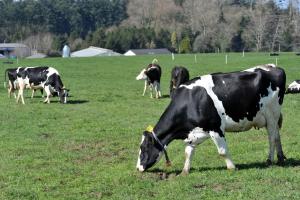Salmonella Dublin is a host-adapted bacterium known to have a significant impact on productivity and welfare in infected cattle herds. Importantly the organism also has zoonotic potential, and is less commonly found to cause disease in other species. Outbreaks are hugely diverse in their manner of presentation.

As the infection is often systemic, a wide range of pathologies and associated clinical signs can occur, in addition to abortion, diarrhoea and septicaemia. Clinical signs of pneumonia and meningitis are not uncommon. Clinical signs may also be chronic and include poor growth rates and illthrift. Sloughing of the extremities is a less frequent, but an obviously notable, clinical sign. There is evidence of seasonality in Salmonella Dublin infection, with an increase in diagnoses during the Autumn season.
The carrier status is a well-recognised complication of Salmonella Dublin infection. Carrier cattle may shed the bacterium constantly, intermittently or may become a latent carrier. Latent carriers can temporarily shed the bacteria in faeces, becoming infective to naïve animals. This shedding is often associated with periods of stress in latent carriers e.g. around calving. Active carriers will also shed in higher numbers around periods of stress.
Control of Salmonella Dublin can be as challenging in an endemically infected herd as in the outbreak situation. There are a number of important basic principles, also applicable to other infectious diseases, in particular Johne’s disease, which should be applied to control the infection. High standards of general hygiene, minimising exposure to faecal material, are essential. Hygiene and management of the calving environment is one of the most important areas to address.
General principles of good calf rearing apply to management of the preweaned calves, as they represent the most susceptible animals to infection on the farm e.g. optimum colostrum management, maintaining a clean environment to minimise exposure to faecal material. Purchase of animals is a significant risk factor, and herd biosecurity and quarantine protocols should be reviewed regularly to reduce risk. Clinically ill animals should be strictly isolated entirely separate from the calving environment. Vaccination may be used, in conjunction with a management programme, to minimise the infective challenge to animals. Zoonotic infections may be acquired by direct contact with cattle or faecal matter, or through ingesting unpasteurised milk products, therefore staff and visitors on farm must practice a high standard of cleanliness and hygiene.
There are two approaches to the diagnosis of Salmonella Dublin, isolation of the organism itself or detection of an antibody response to the organism in an animal. The most appropriate testing strategy will depend on whether a diagnosis is required for an individual animal, or on a herd basis.
The organism itself can be detected by bacterial culture in a number of sample types. Faecal culture is the most common approach. The sensitivity depends on the presentation of the animal, stage of infection and administration of prior antibiotic therapy. Isolation of the organism from the more chronic clinical manifestations, or from treated animals, can prove difficult.
Serological assessment of antibody levels will provide a more sensitive assessment of herd status, compared to attempts to culture Salmonella Dublin. Serological testing can be carried out on blood or milk samples. Peak antibody titres are reached 5-6 weeks after infection, therefore serology is a useful tool for retrospective diagnosis or for monitoring purposes. Maternally derived antibody persists for up to 3 months and can therefore complicate result interpretation if blood sampling calves younger than this. Sensitivity and specificity of the Salmonella Dublin ELISA varies with age of animal sampled. The test performs best in young cattle, 3-10months of age, where sensitivity and specificity are reassuringly high. Therefore it may have a place in identifying seronegative herd replacements in the routine screening of young stock.
Bulk tank milk (BTM) Salmonella Dublin serology testing can be a useful adjunct to herd health planning. Quarterly sampling significantly increases the herd level sensitivity of this test. Four negative results three months apart are required for a herd to be considered to have a herd level prevalence of less than 5%. This can offer an early warning for increased disease risk, allowing hygiene and management procedures to be reviewed and changes implemented promptly by the herd owner and their veterinary surgeon. This test is not suitable to be used in vaccinating herds. If disease is predominantly seen in the youngstock it may be appropriate to combine bulk tank testing with serology testing of calves aged greater than 3 months.
The Veterinary Sciences Division of AFBI offer a range of specialised testing services to aid these disease investigations. Your own veterinary surgeon will be best placed to offer specific advice having knowledge of the current health status of your herd.
Notes to editors:
AFBI is an arms-length body of DAERA delivering research and development, diagnostic and analytical testing, emergency response capability and expert scientific advice for DAERA and other government departments, public bodies and commercial companies in Northern Ireland, and further afield.
AFBI’s Vision is “Advancing the Local and Global Agri-Food Sectors Through Scientific Excellence”.
AFBI’s core areas:
- Leading improvements in the agri-food industry;
- Protecting animal, plant and human health;
- Enhancing the natural and marine environment.
All enquiries to AFBI Press Office afbi.press-office@afbini.gov.uk
Latest news
- Resilience, Sustainability and Innovation survey 03 March 2025
- AFBI led Project Launched to Promote Sustainable Dairy Farming across the UK 18 February 2025
- UK Project Launched to Promote Sustainable Dairy Farming 11 February 2025
- International Day of Women and Girls in Science 11 February 2025
